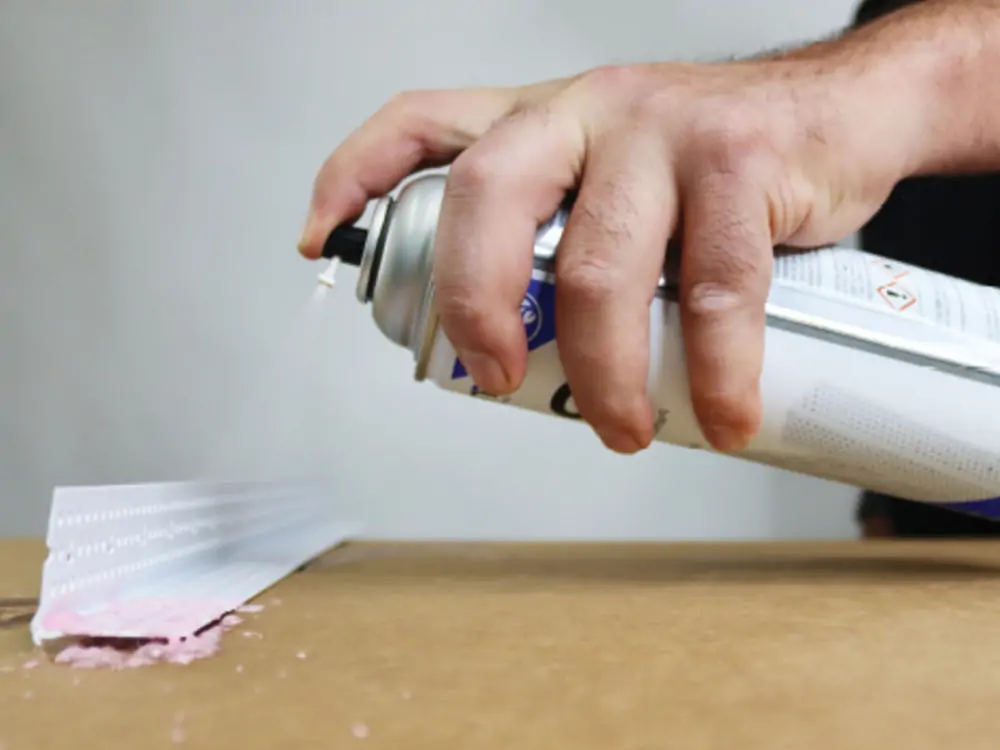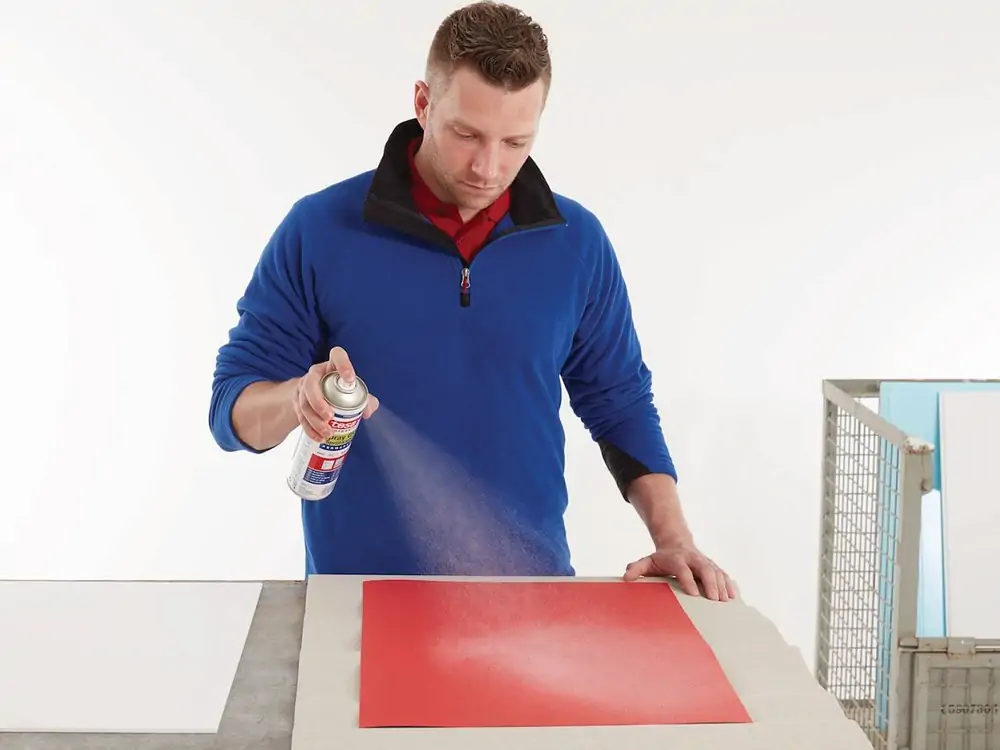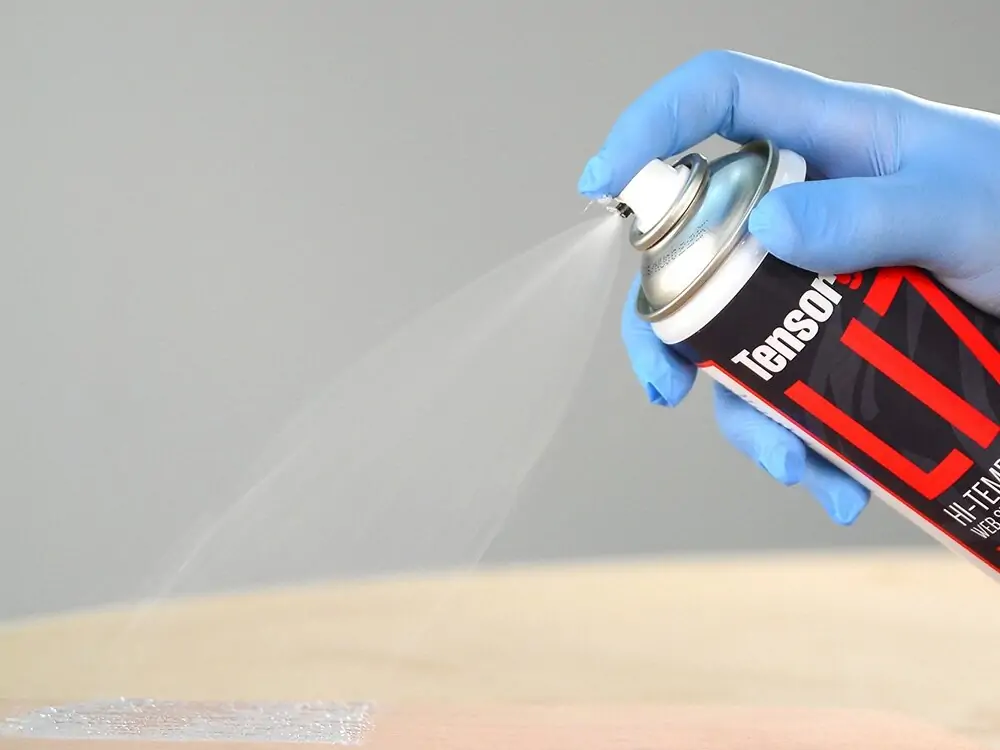Welcome to our blog post that delves into the world of adhesives: mist spray adhesive vs. web spray adhesive. If you’ve ever found yourself puzzled by the variety of adhesive options available, you’re not alone. Choosing the right adhesive is crucial for successful bonding in your projects, whether it’s crafting, woodworking, or DIY repairs.
In this blog, we’ll explain what each adhesive is good for and when to use them. By the end, you’ll know exactly which one to pick for your crafting or repair jobs. Let’s dive in and make your adhesive choices easier.
Without further ado, let’s go
What is Spray Adhesive?

Spray Adhesive, also known as spray adhesive or aerosol adhesive, is a type of glue that comes in a spray can. It is a convenient and easy-to-use adhesive option for various projects. The spray adhesive is designed to bond quickly and securely to various materials, such as paper, fabric, wood, metal, and plastic.
To apply the adhesive spray, you simply spray a fine mist or a web-like pattern of adhesive onto the surface you want to bond. It creates a strong and flexible bond between the materials. It makes ideal for crafts, artwork, DIY projects, and even lightweight repairs.
One key advantage of adhesive spray is its uniform coverage, allowing for even and precise application. It is particularly useful when bonding large surfaces or when working with delicate materials that can’t be done with traditional glues.
How to Choose the Right Spray Adhesive?
Using the right adhesive for your specific needs involves a few simple steps:
- Identify the materials: Determine the materials you want to bond, such as paper, wood, metal, fabric, or plastic. This will help you narrow down the suitable adhesive options.
- Select the adhesive: Based on the materials, choose the right adhesive type. For example, use wood glue for woodworking, fabric glue for textiles, or super glue for quick fixes.
- Read instructions and recommendations: Always read the adhesive product labels, instructions, and recommendations. Follow them carefully for the best results and safety.
- Apply the adhesive: Depending on the type of adhesive, use a brush, nozzle, or applicator to apply a thin, even layer. Avoid excess adhesive, as it can weaken the bond.
Let’s explore the most common types of spray adhesive “mist spray adhesive vs. web spray adhesive” Which one is better?
What is Mist Spray Adhesive?

Mist spray adhesive is a type of aerosol adhesive that dispenses a fine mist of glue when sprayed. It is commonly used for bonding lightweight materials such as paper, cardboard, fabric, and photos. The mist spray provides an even and uniform coating, making it perfect for crafts, scrapbooking, and artwork.
Considerations of Mist Spray Adhesive
To apply mist spray adhesive, here is an important note you need to keep in mind.
- Bond Strength: While mist spray adhesive is excellent for lightweight materials, it may not provide the required strength for heavy-duty or load-bearing applications. For such projects, consider using a stronger adhesive type.
- Coverage Area: Due to the fine mist, mist spray adhesive may not cover large areas as efficiently as other adhesive forms. For extensive applications, consider using adhesive options with wider coverage patterns.
- Drying Time: The quick-drying nature of mist spray adhesive can be advantageous for time-sensitive projects. However, it also means that you must work swiftly to position materials correctly before the bond sets.
- Environmental Impact: Some mist spray adhesives contain Volatile Organic Compounds (VOCs), which can contribute to air pollution and have health implications. Look for low-VOC or VOC-free alternatives to reduce environmental impact.
Pros of Mist Spray Adhesive
- Precision Application: Mist spray adhesive allows for accurate and controlled bonding, preventing excess glue and mess. Its fine mist ensures a consistent coating, enhancing the overall aesthetics of the project.
- Quick Drying: This adhesive type dries rapidly, reducing waiting time and enabling faster project completion. It’s particularly beneficial for time-sensitive tasks or when you need to work efficiently.
- Ideal for Delicate Materials: The gentle mist of adhesive is suitable for bonding delicate materials without causing damage or warping. It is commonly used for photographs, delicate papers, and artworks.
- Clean and Neat Finish: Mist spray results in a professional-looking finish, without visible glue lines or smudges. This enhances the overall appearance of the project and gives it a polished look.
- User-Friendly: The aerosol can design makes mist spray adhesive easy to handle and apply, even for beginners and DIY enthusiasts. Its user-friendly nature simplifies the bonding process.
Cons of Mist Spray Adhesive
- Limited Bond Strength: While mist spray adhesive is excellent for lightweight materials, it may not provide enough strength for heavy-duty or load-bearing applications.
- Coverage Area: Due to the fine mist application, mist spray adhesive may not cover large surfaces as efficiently as other adhesive forms. This may lead to more frequent reapplications and increased adhesive usage.
- Volatile Organic Compounds (VOCs): Some mist spray adhesives contain Volatile Organic Compounds (VOCs), which can be harmful to the environment and human health. Look for low-VOC or VOC-free options to reduce environmental impact.
- Risk of Overspray: Accidental overspray can occur if not used carefully, leading to adhesive wastage and potential mess. It’s essential to apply mist spray adhesive in a well-ventilated area and follow the instructions for proper usage.
What is Web spray adhesive?

Web spray adhesive, lace spray adhesive, is an aerosol adhesive that comes out in a web-like pattern when sprayed. Unlike mist spray adhesive, web spray adhesive creates a pattern of interconnected adhesive strands that resemble a spider’s web. It’s used for strong bonding on heavier materials and larger surfaces. It’s great for woodworking, upholstery, construction, and automotive projects.
Characteristics
Web spray adhesive is designed to provide a web-like pattern of adhesive when applied. This pattern offers a greater bonding surface area, resulting in stronger and more durable connections between materials. It is available in both high-tack and low-tack options, catering to different project requirements.
Pros of Web Spray Adhesive
- Strong Bond: This creates a powerful and long-lasting bond on heavy materials and large surfaces. It ensures reliable connections.
- Wide Coverage: Web-like pattern provides better coverage, reducing the need for frequent reapplications. That’s making bonding larger areas more efficient.
- Versatility: Suitable for woodworking, upholstery, construction, and automotive projects. Because it offers a wide range of applications.
- Fast Drying: It dries quickly, speeding up project completion and minimizing waiting time.
- High-Tack Options: Some web spray adhesives offer high-tack formulations, ensuring a strong initial bond.
Cons of Web Spray Adhesive
- Precision Required: Applying web spray adhesive may need more precision due to the distinct web-like pattern, ensuring proper alignment.
- Potential Overspray: Be careful to avoid adhesive wastage and mess from accidental overspray.
- VOC Content: Some types may contain Volatile Organic Compounds (VOCs), which can be harmful to the environment and health.
- Clean-Up Challenges: Cleaning up excess adhesive may be more challenging due to the web pattern.
Mist Spray Adhesive vs. Web Spray Adhesive: A Quick Comparison
Mist Spray Adhesive
- Best for lightweight materials like paper, fabric, and photos.
- Dispenses a fine mist for precise and clean application.
- Quick-drying, ideal for time-sensitive projects.
- Perfect for crafts, scrapbooking, and delicate artwork.
- May not provide enough bond strength for heavy-duty tasks.
Web Spray Adhesive:
- Suitable for heavier materials and larger surfaces.
- Applies adhesive in a web-like pattern for better coverage.
- Offers a strong and durable bond for woodworking, construction, and upholstery.
- Requires more precision during application due to the web pattern.
- Some options may contain VOCs; consider low-VOC alternatives.
Final Verdict
When comparing mist spray adhesive and web spray adhesive, the answer to which one is better depends on the specific requirements of your project. You need to choose a mist spray adhesive for lightweight and precise tasks. While web spray adhesive is best for heavy-duty projects requiring a robust bond and extensive coverage. Consider the materials, bonding strength, and coverage required to make an informed decision. By selecting the right adhesive, you can achieve successful and long-lasting results in your endeavors.
